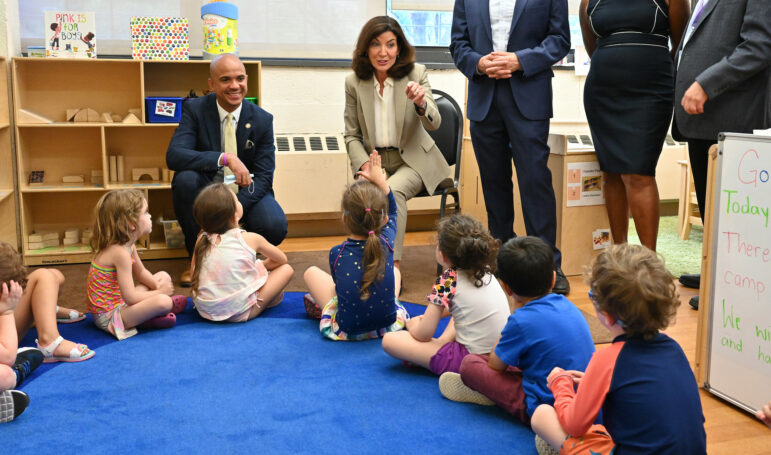“In New York, poverty wages and lack of healthcare access reduce the availability of child care for families and lead to high turnover, destabilizing the lives of young children when they need continuity the most to thrive.”

Kevin P. Coughlin / Office of Governor Kathy Hochul
Gov. Kathy Hochul visiting a childcare center in Washington Heights & Inwood in 2022.Child Care and access to it is the backbone of a healthy economy and society. The pandemic showed all of us just how vital it is for working parents to have access to quality child care programs, ones that operate within a regular working day and operate non-traditional hours.
While the pandemic illuminated the need for access to child care, it also shrunk the field. We have lost over 10,000 slots for children across the state because many providers needed help to stay solvent, make ends meet, feed their families, and pay their bills while caring for and educating children. The child care workforce earns too little and provides so much.
In the last couple of years, the state provided workforce-focused child care stabilization grants, which have been a tremendous support. Yet it is temporary support that will never be enough to solve the child care crisis that predated the pandemic. Even with the support of stabilization grants, 45 percent of New York’s child care programs report experiencing a staffing shortage.
Recent reports show that child care educators and staff, the overwhelming majority of whom are women and over half of whom are women of color, make less than 97 percent of all the workforce. In addition, early childhood educators report that they are unable to pay their bills and most experience some level of food insecurity.
That is why New York State needs to include a $1 billion workforce compensation fund in this year’s budget to raise the average pay of child care professionals by $12,500, as we build a path to a permanently funded compensation ladder by 2025. Our children and their early learning educators are worth the investment: the first 1,000 days, when coupled with quality experiences and learning, can be a strong start for our children.
Other states and localities have done it. Currently, Washington D.C. and Alabama offer bonuses of up to $14,000 per child care educator, with D.C. committed to fully funding a permanent wage scale in fiscal year 2024. As New York considers a minimum wage increase, lawmakers must also create a path to quality wages for all childcare providers.
Washington D.C. is an example which shows that where there is political will, there is a way. The law there was changed so people making over $350,000 per year pay about 1 percent more in taxes, and it has yielded the resources to pay assistant and lead teachers—a pay supplement that has allowed many to dream and have hope.
In addition, healthcare is an option for the child care sector in D.C. If we want to lessen the exodus of early childhood educators, we must figure out how to care for the employees who make the system work so parents and caregivers can make a way for their families.
In New York, poverty wages and lack of healthcare access reduce the availability of child care for families and lead to high turnover, destabilizing the lives of young children when they need continuity the most to thrive. New York State Gov. Kathy Hochul must demonstrate her commitment to childcare by ensuring the workforce stabilization fund is included in the enacted budget to boost the pay of childcare educators.
LaDon Love is executive director of SPACEs in Action in Washington D.C. Jasmine Gripper is executive director of the Alliance for Quality Education, New York.








